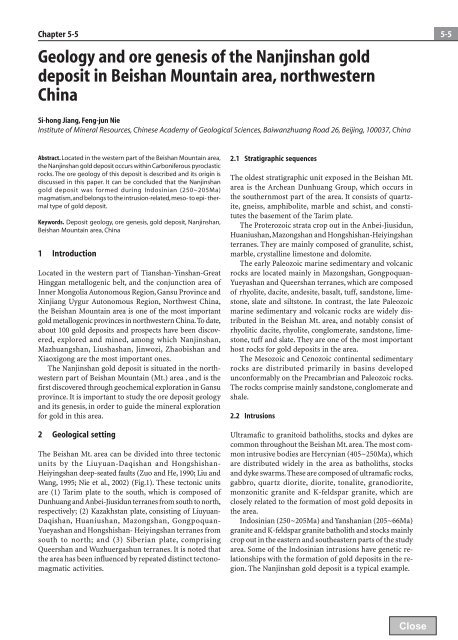Session 5 Epigenetic gold systems - Extra Materials - Springer
Session 5 Epigenetic gold systems - Extra Materials - Springer
Session 5 Epigenetic gold systems - Extra Materials - Springer
You also want an ePaper? Increase the reach of your titles
YUMPU automatically turns print PDFs into web optimized ePapers that Google loves.
Chapter 5-5<br />
Geology and ore genesis of the Nanjinshan <strong>gold</strong><br />
deposit in Beishan Mountain area, northwestern<br />
China<br />
Si-hong Jiang, Feng-jun Nie<br />
Institute of Mineral Resources, Chinese Academy of Geological Sciences, Baiwanzhuang Road 26, Beijing, 100037, China<br />
Abstract. Located in the western part of the Beishan Mountain area,<br />
the Nanjinshan <strong>gold</strong> deposit occurs within Carboniferous pyroclastic<br />
rocks. The ore geology of this deposit is described and its origin is<br />
discussed in this paper. It can be concluded that the Nanjinshan<br />
<strong>gold</strong> deposit was formed during Indosinian (250~205Ma)<br />
magmatism, and belongs to the intrusion-related, meso- to epi- thermal<br />
type of <strong>gold</strong> deposit.<br />
Keywords. Deposit geology, ore genesis, <strong>gold</strong> deposit, Nanjinshan,<br />
Beishan Mountain area, China<br />
1 Introduction<br />
Located in the western part of Tianshan-Yinshan-Great<br />
Hinggan metallogenic belt, and the conjunction area of<br />
Inner Mongolia Autonomous Region, Gansu Province and<br />
Xinjiang Uygur Autonomous Region, Northwest China,<br />
the Beishan Mountain area is one of the most important<br />
<strong>gold</strong> metallogenic provinces in northwestern China. To date,<br />
about 100 <strong>gold</strong> deposits and prospects have been discovered,<br />
explored and mined, among which Nanjinshan,<br />
Mazhuangshan, Liushashan, Jinwozi, Zhaobishan and<br />
Xiaoxigong are the most important ones.<br />
The Nanjinshan <strong>gold</strong> deposit is situated in the northwestern<br />
part of Beishan Mountain (Mt.) area , and is the<br />
first discovered through geochemical exploration in Gansu<br />
province. It is important to study the ore deposit geology<br />
and its genesis, in order to guide the mineral exploration<br />
for <strong>gold</strong> in this area.<br />
2 Geological setting<br />
The Beishan Mt. area can be divided into three tectonic<br />
units by the Liuyuan-Daqishan and Hongshishan-<br />
Heiyingshan deep-seated faults (Zuo and He, 1990; Liu and<br />
Wang, 1995; Nie et al., 2002) (Fig.1). These tectonic units<br />
are (1) Tarim plate to the south, which is composed of<br />
Dunhuang and Anbei-Jiusidun terranes from south to north,<br />
respectively; (2) Kazakhstan plate, consisting of Liuyuan-<br />
Daqishan, Huaniushan, Mazongshan, Gongpoquan-<br />
Yueyashan and Hongshishan- Heiyingshan terranes from<br />
south to north; and (3) Siberian plate, comprising<br />
Queershan and Wuzhuergashun terranes. It is noted that<br />
the area has been influenced by repeated distinct tectonomagmatic<br />
activities.<br />
2.1 Stratigraphic sequences<br />
The oldest stratigraphic unit exposed in the Beishan Mt.<br />
area is the Archean Dunhuang Group, which occurs in<br />
the southernmost part of the area. It consists of quartzite,<br />
gneiss, amphibolite, marble and schist, and constitutes<br />
the basement of the Tarim plate.<br />
The Proterozoic strata crop out in the Anbei-Jiusidun,<br />
Huaniushan, Mazongshan and Hongshishan-Heiyingshan<br />
terranes. They are mainly composed of granulite, schist,<br />
marble, crystalline limestone and dolomite.<br />
The early Paleozoic marine sedimentary and volcanic<br />
rocks are located mainly in Mazongshan, Gongpoquan-<br />
Yueyashan and Queershan terranes, which are composed<br />
of rhyolite, dacite, andesite, basalt, tuff, sandstone, limestone,<br />
slate and siltstone. In contrast, the late Paleozoic<br />
marine sedimentary and volcanic rocks are widely distributed<br />
in the Beishan Mt. area, and notably consist of<br />
rhyolitic dacite, rhyolite, conglomerate, sandstone, limestone,<br />
tuff and slate. They are one of the most important<br />
host rocks for <strong>gold</strong> deposits in the area.<br />
The Mesozoic and Cenozoic continental sedimentary<br />
rocks are distributed primarily in basins developed<br />
unconformably on the Precambrian and Paleozoic rocks.<br />
The rocks comprise mainly sandstone, conglomerate and<br />
shale.<br />
2.2 Intrusions<br />
Ultramafic to granitoid batholiths, stocks and dykes are<br />
common throughout the Beishan Mt. area. The most common<br />
intrusive bodies are Hercynian (405~250Ma), which<br />
are distributed widely in the area as batholiths, stocks<br />
and dyke swarms. These are composed of ultramafic rocks,<br />
gabbro, quartz diorite, diorite, tonalite, granodiorite,<br />
monzonitic granite and K-feldspar granite, which are<br />
closely related to the formation of most <strong>gold</strong> deposits in<br />
the area.<br />
Indosinian (250~205Ma) and Yanshanian (205~66Ma)<br />
granite and K-feldspar granite batholith and stocks mainly<br />
crop out in the eastern and southeastern parts of the study<br />
area. Some of the Indosinian intrusions have genetic relationships<br />
with the formation of <strong>gold</strong> deposits in the region.<br />
The Nanjinshan <strong>gold</strong> deposit is a typical example.<br />
5-5

















